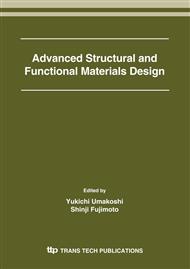[1]
A. Fujita,Y. Akamatsu and K. Fukamichi: J. Appl. Phys. Vol. 85 (1999), p.4756.
Google Scholar
[2]
S. Fujieda, A. Fujita and K. Fukamichi: Appl. Phys. Lett. Vol. 81 (2002), p.1276.
Google Scholar
[3]
A. Fujita, S. Fujieda, K. Fukamichi, Y. Yamazaki and Y. Iijima: Mater. Trans. Vol. 43 (2002), p.1202.
Google Scholar
[4]
A. Fujita, S. Fujieda, Y. Hasegawa and K. Fukamichi: Phys. Rev. B Vol. 67 (2003), p.104416.
Google Scholar
[5]
S. Fujieda, A. Fujita and K. Fukamichi: Sci. Tech. Adv. Mater. Vol. 4 (2003), p.339.
Google Scholar
[6]
S. Fujieda, Y. Hasegawa, A. Fujita and K. Fukamichi: J. Magn. Magn. Mater. Vol. 272-276 (2004) p.2365.
Google Scholar
[7]
V. K. Pecharsky and K. A. Gschneidner, Jr: J. Appl. Phys. Vol. 90 (2001) p.4614.
Google Scholar
[8]
A. M. Tishin and Y. I. Spichkin: in: The Magnetocaloric Effect and Its Applications, Series in Condensed Matter Physics, IOP, London, (2003).
Google Scholar
[9]
T. T. M. Palstra, J. A. Mydosh, G. J. Nieuwenhuys, A. M. Van der Kraan and K. H. J. Buschow: J. Magn. Magn. Mater. Vol. 36 (1983), p.290.
Google Scholar
[10]
A. Fujita, K. Fukamichi, M. Yamada and T. Goto: J. Appl. Phys. Vol. 93 (2003), p.7263.
Google Scholar
[11]
A. Iandelli and A. Palenzona: in Crystal Chemistry of Intermetallic Compounds, Handbook on the Physics and Chemistry of Rare Earths, edt. By K. A. Gschneidner, Jr and L. Eyring, Vol. 2 Chap. 13 (1979 North Holland).
DOI: 10.1016/s0168-1273(79)02004-3
Google Scholar
[12]
S. Fujieda, A. Fujita and K. Fukamichi: J. Alloy. Compnd. (2005), in press.
Google Scholar
[13]
H. Yamada: Phys. Rev. B Vol. 47 (1993), p.11211.
Google Scholar
[14]
A. Fujita, K. Fukamichi, J. -T. Wang and Y. Kawazoe: Phys. Rev. B Vol. 68 (2003) 104431.
Google Scholar
[15]
A. Fujita and K. Fukamichi, IEEE Trans. Magn. Vol. 35 (1999) p.3796.
Google Scholar
[16]
S. Fujieda, Y. Hasegawa, A. Fujita and K. Fukamichi: J. Appl. Phys. Vol. 95 (2004), p.2429.
Google Scholar
[17]
A. O. Pecharsky, K. A. Gschneidner, Jr. and V. K. Pecharsky: J. Appl. Phys. Vol. 93 (2003), p.4722.
Google Scholar
[18]
O. Tegus, E. Brück, L. Zhang, W. Dagula, K. H. J. Buschow, F. R. de Boer: Physica B Vol. 319 (2002), p.174.
DOI: 10.1016/s0921-4526(02)01119-5
Google Scholar
[19]
T. Tohei, H. Wada and T. Kanomata: J. Appl. Phys. Vol. 94 (2003), p.1800.
Google Scholar
[20]
E. M. Levin, A. O. Pecharsky, V. K. Pecharsky and K. A. Gschneidner, Jr: Phys. Rev. B Vol. 63 (2001), 064426.
Google Scholar


